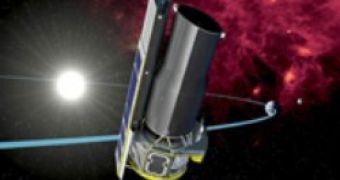Astronomers were able to identify for the first time a dark object that seems to be a double black hole located around 16,000 light-years away from our solar system, using a new technique called cosmic triangulation.
In trigonometry and elementary geometry, triangulation is the process of finding coordinates and distance to a point by calculating the length of one side of a triangle, given measurements of angles and sides of the triangle formed by that point and two other known reference points, using the law of sines.
Cosmic triangulation is a similar process that involved using NASA's Spitzer Space Telescope and was the determination of a distance to a microlensing event that occurred in the summer of 2005. Similar to the way other scientists determine the distance to a mountaintop, this technique took measurements from two points. The two points were an Earth based telescope and the Spitzer Telescope, which orbits the sun some 40 million kilometers behind Earth.
A team of astronomers led by Andrew Gould and Subo Dong, of Ohio State University in Columbus, used the technique to look at an invisible object that floats around the outskirts of our galaxy.
The microlensing event was detected by Spitzer at a slightly different time than did astronomers on Earth, so astronomers used the gap to determine that the lens was in the Milky Way's halo, not in the more distant Magellanic Cloud. Therefore, the microlensing was due to a MACHO.
A MACHO is a "Massive Compact Halo Object" that can't be seen directly and scientists think they are made up of dark matter in its two varieties, the theorized but yet-to-be-discovered elementary particles and invisible matter consisting of normal atoms.
The latter's nature hasn't yet been determined, but theorists expect dim stars, free-floating planets and black holes to lurk in the extended halo of the Milky Way. When a MACHO passes directly in front of a visible object, like a visible star, the gravity of the dark object amplifies the star's light, acting as a tiny gravitational lens. This is called a microlensing event.
An extended analysis of the event showed that it's made up of two celestial bodies that weigh in at three and seven times the mass of the sun, respectively.
"Stars that massive would be visible, so the MACHO is probably a binary black hole", concluded Dong.

 14 DAY TRIAL //
14 DAY TRIAL //